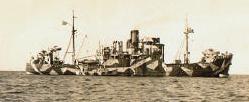
Shin'yō Maru was a cargo steamship that was built in 1894, had a fifty-year career under successive British, Australian, Chinese and Greek owners, was captured by Japan in the Second World War, and sunk by a United States Navy submarine in 1944.

SS Clan Alpine was a UK steam cargo liner. She was launched in 1918 and sunk by a U-boat in 1943.

SS Clan Fraser was a British cargo steamship. She served in the Second World War and was bombed and sunk in Greece in 1941.

SS Clan Chisholm was a British cargo steamship. She was torpedoed and sunk in the Second World War while carrying cargo from India to Scotland.

The SS Clan Forbes was a British cargo steamship. She was built for Clan Line Steamers Ltd as one of its Cameron-class steamships. She was launched at Greenock in 1938, served in the Second World War and was scrapped in Hong Kong 1959.
SS Clan Macneil was a UK steam cargo liner. She was launched in 1921, survived the Second World War and scrapped in 1952. She spent her entire career with Clan Line.

Wickenburgh was a cargo liner that was built in 1938 as Adler by Lübecker Maschinenbau Gesellschaft, Lübeck for German owners. Requisitioned by the Kriegsmarine in 1940, she was seized by the Allies in Vordingborg, Denmark in May 1945, passed to the Ministry of War Transport (MoWT) and renamed Empire Coningsby. In 1946, she was transferred to the Dutch Government and renamed Margeca. In 1947 she was sold into merchant service and renamed Wickenburgh. In 1953 her compound steam engine and low-pressure steam turbine were replaced with a diesel engine, with a reduction in gross register tonnage from 1,494 to 1,420. She was sold to Greek owners in 1963 and renamed Nissos Thassos. In 1970 she was sold to Panamanian owners and renamed Savilco. She was scrapped in 1984.
SS Dover Hill was a United Kingdom shelter deck cargo steamship. She was launched as Maenwen but before she was completed Clan Line bought her and renamed her Clan Macvicar. She spent most of her career under this name, but is noted for her Second World War service under her later name Dover Hill.
SS Hertford was a refrigerated cargo steamship that was launched in Germany in 1917, seized by the United Kingdom in 1920 as World War I reparations, and sunk by a U-boat in 1942 with the loss of four members of her crew.
SS Clan Macarthur was a British refrigerated cargo steamship. She was built for Cayzer, Irvine and Company's Clan Line Steamers Ltd as one of its Cameron-class steamships. She was launched in Greenock in 1936 and sunk in the Indian Ocean by enemy action in August 1943.

SS Karsik was a German-built cargo steamship. Deutsche Schiff- und Maschinenbau (Deschimag) built her as Soneck for Deutsche Dampfschifffahrts-Gesellschaft "Hansa" in 1938.
SS Clan Macfadyen was a UK steam cargo liner. She was launched in 1923 and spent her entire career with Clan Line. A U-boat sank her in 1942 with the loss of 82 lives.
SS City of Bedford was a British cargo steamship. She was launched in 1924 in Sunderland for Hall Line Ltd of Liverpool, a member of the Ellerman Lines group.

SS Bärenfels was a German steam cargo liner that was launched in 1921 for DDG Hansa. In 1940, she took part in the German invasion of Norway and was sunk by Fleet Air Arm dive bombers. Her wreck was raised, and in 1941, she was returned to service. In 1944, a Royal Navy midget submarine sank her, killing 11 of her complement. In 1947, her wreck was raised to be scrapped, but while under tow she sank a third time.
SS Huntingdon was a refrigerated steam cargo liner that was built in Germany in 1920 as Münsterland. The United Kingdom took her as war reparations and sold her to the Federal Steam Navigation Company, who renamed her Huntingdon. She operated between Britain and Australasia until 1941, when an Italian submarine sank her in the Atlantic Ocean.
SS Jumna was a steam passenger liner that was built in Scotland in 1929 and sunk with all hands by a German cruiser on Christmas Day 1940. She was a ship in the fleet of James Nourse, Ltd, whose trade included taking indentured labourers from India to the British West Indies.
HMS Malvernian was an Ellerman Lines cargo steamship that was built in 1937. In January 1941 she was converted into an ocean boarding vessel. That July she sank after a German air attack crippled her in the Atlantic Ocean.
SS Florian was an Ellerman Lines cargo steamship that was launched in 1939 and completed in 1940. A U-boat sank her with all hands in 1941 in the Battle of the Atlantic.

Rhineland was a 1,312 GRT cargo steamship that Howaldtswerke of Kiel, Germany built in 1938 for Argo Line, Bremen. She was requisitioned by the Kriegsmarine in 1939, and served as VP-101 Schwan, Sperrbrecher 31 and Sperrbrecher 131. She served post-war with the German Mine Sweeping Administration before being declared a prize and passed to British owners. She was renamed Weltonwold in 1948 and then Rhineland in 1949. She was sold to South African owners in 1956 and renamed Herrisbrook. She was renamed Inyoni in 1957 and scrapped in 1962.
SS Adderstone was a cargo ship that was built in Ireland in 1920. She was launched as the turbine steamship War Bamboo, and for most of her career she was called Boswell (1920–34), Germa (1937–51), or Norway Maru (1951–1968/70). She spent only about three years as Adderstone (1934–37). However, it was as Adderstone that the ship was the test-bed for an innovative development in marine steam propulsion, which used reduction gearing not only for an exhaust steam turbine but also for a high-speed reciprocating steam engine.









